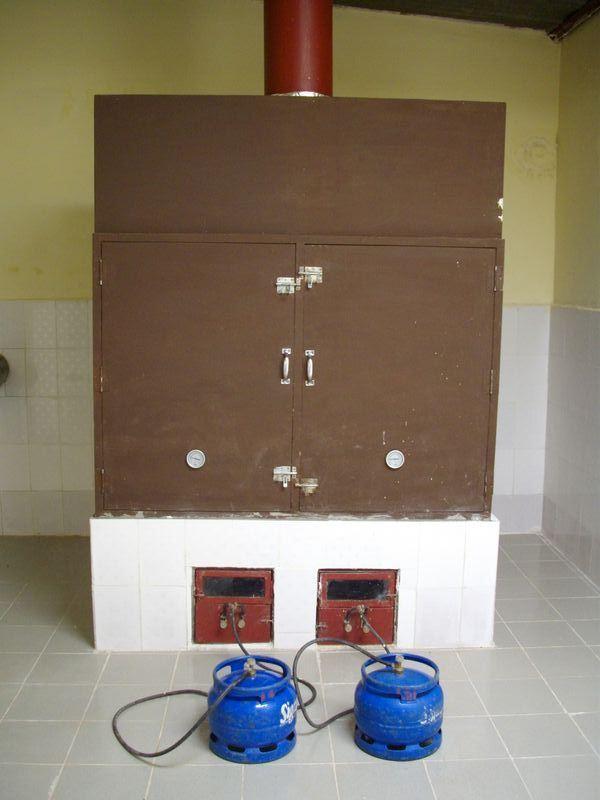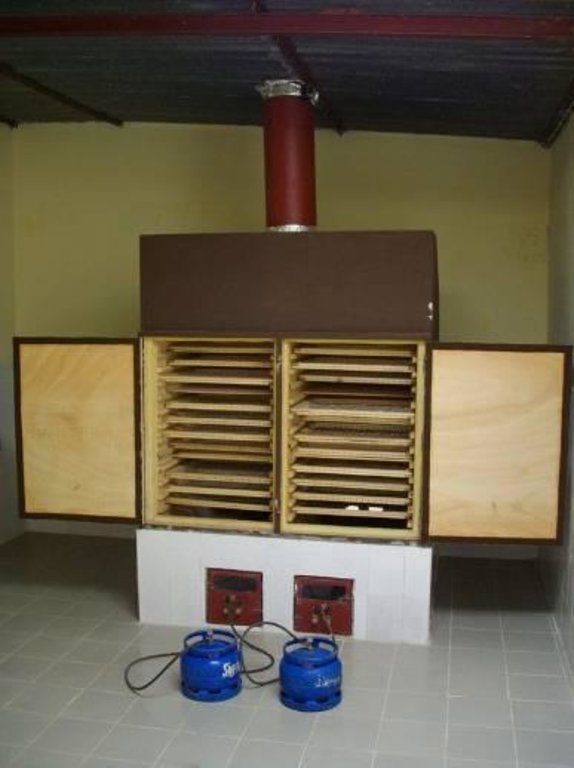Using gas dryers (Atesta-Sikasso) to process animal and vegetable products [马里]
- 创建:
- 更新:
- 编制者: Dieter Nill
- 编辑者: –
- 审查者: Fabian Ottiger
Utilisation du séchoir a gaz (type Atesta-Sikasso) pour traitement des produits d’origine végétale et animale (French)
technologies_1641 - 马里
查看章节
全部展开 全部收起1. 一般信息
1.2 参与该技术评估和文件编制的资源人员和机构的联系方式
SLM专业人员:
Assarki Oumar
Agricultural Competitiveness and Diversification Programme (PCDA)
ACI 2000 Hamdallaye, rue 317, porte 359, BP : 228 Bamako 3, Mali
马里
有助于对技术进行记录/评估的项目名称(如相关)
Manual of Good Practices in Small Scale Irrigation in the Sahel (GIZ )有助于对技术进行记录/评估的机构名称(如相关)
Agricultural Competitiveness and Diversification Programme (PCDA) - 马里有助于对技术进行记录/评估的机构名称(如相关)
Deutsche Gesellschaft für Internationale Zusammenarbeit (GIZ) GmbH (GIZ) - 德国1.3 关于使用通过WOCAT记录的数据的条件
(现场)数据是什么时候汇编的?:
01/07/2012
编制者和关键资源人员接受有关使用通过WOCAT记录数据的条件。:
是
2. SLM技术的说明
2.1 技术简介
技术定义:
This multipurpose dryer is used to dry animal and vegetable products (mango, tomato, coconut, ginger, meat, etc.).
2.2 技术的详细说明
说明:
It comprises: 2 compartments, 2 thermometers, 4 burners, 20 trays and 4 baffles. The drying process is natural (natural convection). Moving produce around the unit (top to bottom, back to front) every two hours helps homogenise the drying process.
Purpose of the Technology: The objectives of using a dryer are: to improve productivity and the quality of dried mango; to demonstrate the technical and economic benefits of the system; to promote the use of Atesta dryers among processing outfits.
There are reduced drying times (100 kilograms of pulp in 20 hours) and improved product quality (good colour and taste). The total output quantity from each production cycle is 14 kilograms of dried mango from 100 kilograms of mango pulp / output quality: 10 kilograms prime quality, 4 kilograms secondary quality. A minimum quantity of 524 kilograms must be produced to make the activity profitable. The dryer has a lifespan of five years.
Establishment / maintenance activities and inputs: Source and quantity of energy used: 12 kilograms of gas in 24 hours. Duration of machine operation: 20 hours per production cycle. Drying temperature: 70 to 80ºC. Water content of end product: 15%. Duration of activities: 24 hours. Type of raw material: fresh mango. Receipt/sorting/weighing of raw material: 100 kilograms of mango pulp per production cycle. Cleaning and preparing the raw material: washing in chlorinated water (3 to 5 drops per litre), peeling, stone removal, and cutting into slices one to five millimetres thick. Processing operations: Packaging the final product in plastic sachets of 100, 200 and
500 grams, and one kilogram.
Implementation: The dryer is on show at Ségou demonstration centre where promoters come and express their interest. Interested parties then apply to PCDA. These applications are reviewed by the Regional Centre for the Approval of Sub-Projects (CRAP), which comprises the governor, banks, research and oversight bodies (ROBs) and inter-branch organisations. Once approved by CRAP, the project must subsequently be approved by the National Centre for the Approval of Sub-Projects (CNAP) in Bamako. Successful promoters are informed and then pay their contribution. PCDA and the ROBs provide training and support, and carry out monitoring. Part of the training involves exchange trips to visit promoters outside the region. Roles of the actors involved: PCDA promotes innovations, subsidises financing, provides support and undertakes evaluation. ROBs carry out studies, monitoring and reporting, and support
promoters. Banks/microfinance institutions provide co-funding and loans, and
train up promoters. Promoters contribute financially to their training and implement the project.
2.3 技术照片
2.5 已应用该技术的、本评估所涵盖的国家/地区/地点
国家:
马里
区域/州/省:
Mali
有关地点的进一步说明:
Sikasso town, Bougouni, Koutiala, Bamako and Ségou
2.6 实施日期
如果不知道确切的年份,请说明大概的日期:
- 不到10年前(最近)
2.7 技术介绍
详细说明该技术是如何引入的:
- 通过项目/外部干预
注释(项目类型等):
Since 2005, through Agricultural Competitiveness and Diversification Programme (PCDA)
3. SLM技术的分类
3.1 该技术的主要目的
- 创造有益的经济影响
- 创造有益的社会影响
3.2 应用该技术的当前土地利用类型

农田
- 一年一作
主要农作物(经济作物及粮食作物):
Major food crop: Rice

混合(作物/放牧/树木),包括农林
注释:
Major land use problems (compiler’s opinion): low quantity and quality of dried animal products and vegetables
Mixed: (eg agro-pastoralism, silvo-pastoralism): Yes
3.3 有关土地利用的更多信息
该技术所应用土地的供水:
- 混合雨水灌溉
每年的生长季节数:
- 1
具体说明:
Longest growing period in days: 120 Longest growing period from month to month: August-November
牲畜密度(如相关):
1-10 LU /km2
3.4 该技术所属的SLM组
- 收割后的措施
3.5 技术传播
注释:
Around 20 units installed
3.6 包含该技术的可持续土地管理措施

管理措施
- M7:其它
注释:
Main measures: management measures
Specification of other management measures: gas dryer
3.7 该技术强调的主要土地退化类型
3.8 防止、减少或恢复土地退化
具体数量名该技术与土地退化有关的目标:
- 防止土地退化
4. 技术规范、实施活动、投入和成本
4.2 技术规范/技术图纸说明
Technical knowledge required for field staff / advisors: high
Technical knowledge required for land users: moderate (Need for a certain level of technical know-how (regulating temperatures, following technical procedures, etc.))
Main technical functions: promotion of vegetation species and varieties (quality, eg palatable fodder), Reduction in drying times, Improved product quality and quantity
Other type of management: gas dryer
4.3 有关投入和成本计算的一般信息
其它/国家货币(具体说明):
CFA Franc
注明美元与当地货币的汇率(如相关):1美元=:
517.0
4.4 技术建立活动
| 活动 | 措施类型 | 时间 | |
|---|---|---|---|
| 1. | Interested parties apply for dryer and pay their contribution | 管理 | |
| 2. | Training (involves exchange trips to visit promoters outside the region) | 管理 |
4.6 维护/经常性活动
| 活动 | 措施类型 | 时间/频率 | |
|---|---|---|---|
| 1. | Drying process: Receipt/sorting/weighing of raw material: 100 kilograms of mango pulp per production cycle. Cleaning and preparing the raw material: washing in chlorinated water (3 to 5 drops per litre), peeling, stone removal, and cutting into slices one to five millimetres thick. | 管理 | |
| 2. | Processing operations: Packaging the final product in plastic sachets of 100, 200 and 500 grams, and one kilogram. | 管理 |
4.8 影响成本的最重要因素
描述影响成本的最决定性因素:
Investment costs: 1,760,000 CFA Francs (3,376 Dollar).
Turnover = total production x unit price = 3,975,000 CFA Francs. Production cost (CFA francs/kilogram) = (variable costs + fixed costs) / output quantity = (2,428,000 + 460,000) = 2,888,000 CFA francs / 1,400 kilograms = 2,063 CFA Francs; Net return = turnover - total cost of production = 3,975,000 - 2,888,000 = 1,087,000 CFA Francs; Contribution margin = turnover - variable costs = 3,975,000 - 2,428,000 = 1,547,000 CFA Francs; Contribution margin rate = contribution margin / turnover = 1,547,000 / 3,975,000 CFA francs = 39%; Production costs: each kilogram of processed dried mango incurs a cost of 2,063 CFA Francs; Break-even point in terms of quantity: a minimum quantity of 524 kilograms must be produced to make the activity profitable
5. 自然和人文环境
5.1 气候
年降雨量
- < 250毫米
- 251-500毫米
- 501-750毫米
- 751-1,000毫米
- 1,001-1,500毫米
- 1,501-2,000毫米
- 2,001-3,000毫米
- 3,001-4,000毫米
- > 4,000毫米
农业气候带
- 半干旱
Thermal climate class: tropics
5.2 地形
平均坡度:
- 水平(0-2%)
- 缓降(3-5%)
- 平缓(6-10%)
- 滚坡(11-15%)
- 崎岖(16-30%)
- 陡峭(31-60%)
- 非常陡峭(>60%)
地形:
- 高原/平原
- 山脊
- 山坡
- 山地斜坡
- 麓坡
- 谷底
垂直分布带:
- 0-100 m a.s.l.
- 101-500 m a.s.l.
- 501-1,000 m a.s.l.
- 1,001-1,500 m a.s.l.
- 1,501-2,000 m a.s.l.
- 2,001-2,500 m a.s.l.
- 2,501-3,000 m a.s.l.
- 3,001-4,000 m a.s.l.
- > 4,000 m a.s.l.
5.3 土壤
平均土层深度:
- 非常浅(0-20厘米)
- 浅(21-50厘米)
- 中等深度(51-80厘米)
- 深(81-120厘米)
- 非常深(> 120厘米)
土壤质地(表土):
- 中粒(壤土、粉土)
- 细粒/重质(粘土)
表土有机质:
- 中(1-3%)
- 低(<1%)
如有可能,附上完整的土壤描述或具体说明可用的信息,例如土壤类型、土壤酸碱度、阳离子交换能力、氮、盐度等。:
Soil fertility: Medium
Soil drainage/infiltration: Medium and poor
Soil water storage capacity: Medium
5.4 水资源可用性和质量
地下水位表:
5-50米
地表水的可用性:
中等
水质(未处理):
仅供农业使用(灌溉)
关于水质和水量的注释和进一步规范:
Availability of surface water: Also poor/ none
5.5 生物多样性
物种多样性:
- 中等
关于生物多样性的注释和进一步规范:
Species diversity: Also low
5.6 应用该技术的土地使用者的特征
生产系统的市场定位:
- 混合(生计/商业
非农收入:
- 收入的10-50%
相对财富水平:
- 贫瘠
- 平均水平
机械化水平:
- 手工作业
性别:
- 男人
说明土地使用者的其他有关特征:
Population density: < 10 persons/km2
Annual population growth: 2% - 3%
10% of the land users are rich.
50% of the land users are average wealthy.
30% of the land users are poor.
10% of the land users are poor.
5.7 应用该技术的土地使用者拥有或租用的平均土地面积
- < 0.5 公顷
- 0.5-1 公顷
- 1-2 公顷
- 2-5公顷
- 5-15公顷
- 15-50公顷
- 50-100公顷
- 100-500公顷
- 500-1,000公顷
- 1,000-10,000公顷
- > 10,000公顷
这被认为是小规模、中规模还是大规模的(参照当地实际情况)?:
- 小规模的
5.8 土地所有权、土地使用权和水使用权
注释:
The irrigated land is allocated by the chief
5.9 进入服务和基础设施的通道
健康:
- 贫瘠
- 适度的
- 好
教育:
- 贫瘠
- 适度的
- 好
技术援助:
- 贫瘠
- 适度的
- 好
就业(例如非农):
- 贫瘠
- 适度的
- 好
市场:
- 贫瘠
- 适度的
- 好
能源:
- 贫瘠
- 适度的
- 好
道路和交通:
- 贫瘠
- 适度的
- 好
饮用水和卫生设施:
- 贫瘠
- 适度的
- 好
金融服务:
- 贫瘠
- 适度的
- 好
6. 影响和结论性说明
6.1 该技术的现场影响
社会经济效应
生产
土地管理
收入和成本
农业收入
其它社会经济效应
Product quality
注释/具体说明:
Increased quality and quantity of dry animal products and vegetables
社会文化影响
食品安全/自给自足
Improved livelihoods and human well-being
注释/具体说明:
Reduced drying times and improved product quality. Each kilogram of processed dried mango incurs a cost of 2,063 CFA Francs; break-even point in terms of quantity: a minimum quantity of 524 kilograms must be produced to make the activity profitable.
生态影响
其它生态影响
Efficiency
注释/具体说明:
more efficient use of resources (e.g. food products), reduced pressure on land
6.3 技术对渐变气候以及与气候相关的极端情况/灾害的暴露和敏感性(土地使用者认为的极端情况/灾害)
渐变气候
渐变气候
| 季节 | 气候变化/极端天气的类型 | 该技术是如何应对的? | |
|---|---|---|---|
| 年温度 | 增加 | 好 |
气候有关的极端情况(灾害)
气象灾害
| 该技术是如何应对的? | |
|---|---|
| 局地暴雨 | 好 |
| 局地风暴 | 好 |
气候灾害
| 该技术是如何应对的? | |
|---|---|
| 干旱 | 好 |
水文灾害
| 该技术是如何应对的? | |
|---|---|
| 比较和缓的(河道)洪水 | 好 |
其他气候相关的后果
其他气候相关的后果
| 该技术是如何应对的? | |
|---|---|
| 缩短生长期 | 好 |
6.4 成本效益分析
技术收益与技术建立成本相比如何(从土地使用者的角度看)?
短期回报:
稍微积极
长期回报:
积极
技术收益与技术维护成本/经常性成本相比如何(从土地使用者的角度看)?
短期回报:
积极
长期回报:
积极
6.7 该技术的优点/长处/机会
| 编制者或其他关键资源人员认为的长处/优势/机会 |
|---|
| Reduced drying times: 100 kilograms of pulp in 20 hours |
| Improved product quality: good colour and taste |
| Total output quantity from each production cycle: 14 kilograms of dried mango from 100 kilograms of mango pulp / output quality: 10 kilograms prime quality, 4 kilograms secondary quality |
| Creation by promoters of a ‘drying school’ in Sikasso |
6.8 技术的弱点/缺点/风险及其克服方法
| 编制者或其他关键资源人员认为的弱点/缺点/风险 | 如何克服它们? |
|---|---|
| Material constraints: sourcing gas and appropriate packaging (availability, airtightness, etc.) | |
| gas supply problems: large gas bottles not subsidised by the state (only small bottles are) | |
| Need for a certain level of technical know-how (regulating temperatures, following technical procedures, etc.) |
7. 参考和链接
7.2 参考可用出版物
标题、作者、年份、ISBN:
Agricultural Competitiveness and Diversification Programme (PCDA) (2008): Référentiel technico-économique. Séchage de la mangue au séchoir à gaz, Atesta-Sikasso [Technical and economic reference document: Drying mango with a gas dryer (Atesta-Sikasso)]
7.3 链接到网络上可用的相关信息
标题/说明:
Manual of Good Practices in Small Scale Irrigation in the Sahel. Experiences from Mali. Published by GIZ in 2014.
URL:
http://star-www.giz.de/starweb/giz/pub/servlet.starweb
链接和模块
全部展开 全部收起链接
无链接
模块
无模块




